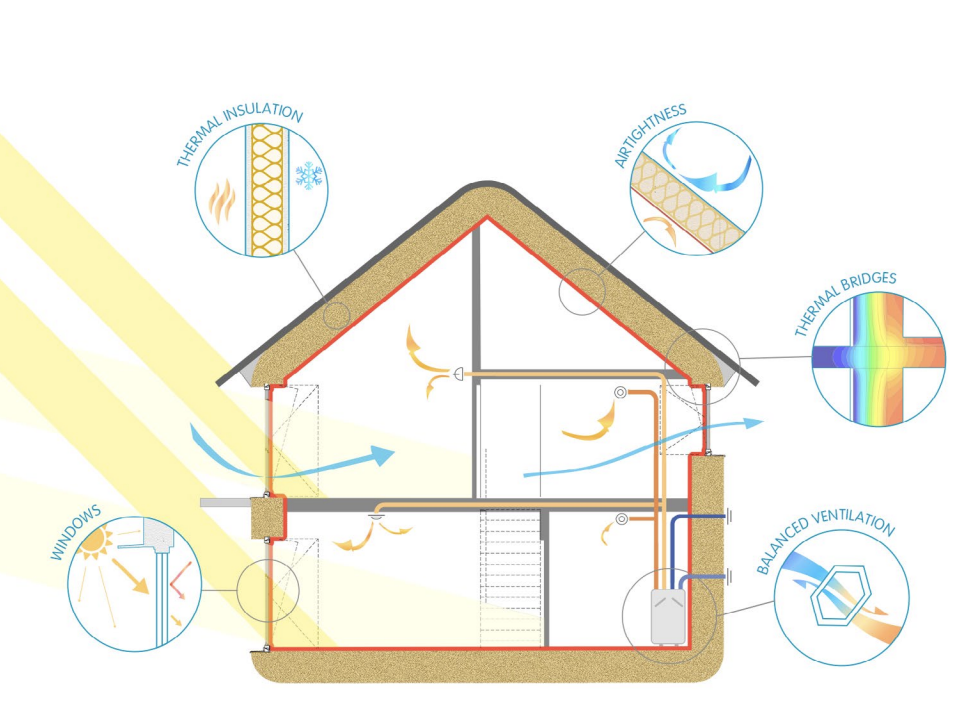Building healthy homes using the Passivhaus standard
At Toa Homes, we believe every whānau deserves a home that actively supports their health and wellbeing. That's why we've chosen the Passivhaus standard as our north star – a proven building standard that creates homes where tamariki can thrive, energy bills stay low, and families can focus on what matters most.
What is a Passivhaus and why does it matter?
Passivhaus is a building standard that puts the health and comfort of the people living inside at the centre of everything. By focusing on detailed performance and comfort criteria, accurate performance modelling and rigorous quality assurance, Passivhaus homes maintain comfortable temperatures year-round while using up to 90% less energy for heating and cooling than typical New Zealand homes. No more waking up to condensation on windows or worrying about damp, mouldy air that our tamariki and kaumātua are breathing.
This dual benefit – energy efficiency and health – aligns perfectly with our mission at Toa Homes. Poor health holds us back from achieving our potential as individuals, whānau, and as a nation. Passivhaus provides a strict, internationally recognised methodology that ensures a healthy environment to live in, year-round.
What we mean by home "performance"
When we talk about how a home performs, we're talking about the same things you care about every day: Will it keep your family warm in winter and cool in summer? Will your power bills be reasonable? Will the air be fresh and healthy? Will it do these things reliably, year after year?
Passivhaus lets us predict and verify these outcomes before we even break ground, giving you complete confidence in your investment.
How we achieve Passivhaus performance
What sets Passivhaus apart isn't just better building components – it's a completely different approach that ensures your home will perform as promised. Our panel system is built around the three core Passivhaus principles that ensure real-world results:
1. Detailed performance and comfort targets
Instead of just meeting minimum building code requirements, we set specific, measurable targets for how comfortable and energy-efficient your home will be. This means we can confidently predict you'll have consistent 20-25°C temperatures year-round and precise energy performance.
2. Accurate performance modelling
Before we build anything, we use specialised Passivhaus software to model exactly how your home will perform. This isn't guesswork – we can predict your energy bills, comfort levels, and air quality with remarkable accuracy based on proven science and data.
3. Rigorous quality assurance
Independent certification by the Passivhaus Institute (PHI) in Germany ensures your home actually delivers what we've modelled and designed for.
These three principles guide how we implement the technical components – high-performance insulation, airtight construction, triple-glazed windows, elimination of thermal bridges, and mechanical ventilation with heat recovery. But more importantly, they ensure these components work together as a system to deliver the comfort, health, and energy savings you're investing in.
Five key Passivhaus building principles.
Most of the Toa Homes set designs are capable of being Passivhaus certified (Classic, Plus, Premium or the PHI Low Energy Building Standard), giving whānau the confidence that their new home will perform as promised.
Making Passivhaus accessible
Building a home is one of the biggest investments most whānau will make. Using our panel system we can now build healthy, high-performing homes at a similar cost to an entry-level new build.
The bigger picture is even more compelling. When you consider the total cost of homeownership (including energy bills, health impacts, and long-term value) Passivhaus represents exceptional value:
Energy savings: Passivhaus homes use up to 90% less energy for heating and cooling than conventional New Zealand homes, while maintaining temperatures of 20-25°C in all rooms of the house. The average Kiwi household spends around $825+ per year on heating and cooling combined, meaning Passivhaus homes can save up to $740 annually on heating and cooling costs. Over a 30-year mortgage, this can amount to up to $22,000 in savings.
Health benefits: Living in cold, damp, poorly ventilated homes leads to serious illness and doesn't provide the safe environment our tamariki need to thrive. While it's difficult to put a dollar figure on avoiding respiratory issues or reducing doctor visits, these health benefits represent real value for whānau wellbeing.
Future value: As energy costs continue to rise, homes that use minimal energy protect whānau from energy poverty while embodying kaitiakitanga and sustaining both people and resources for future generations.
Healthy homes for every whānau
At Toa Homes, we’re creating homes that don't just shelter families, but actively support their health and help them thrive. By combining Passivhaus standards with our innovative panel system, we're proving that exceptional performance doesn't require exceptional budgets.
This is more than building homes – it's about restoring the prosperity of our communities, one whare at a time. By choosing Passivhaus standards today, we're building the foundation for a more sustainable and affordable housing future where tamariki can grow up healthy, where whānau can prosper, and where multi-generational wellbeing becomes the norm.

